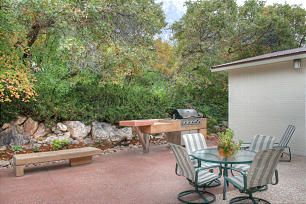By Ann Robinson and Annie Schwemmer
With the advent of spring, we enjoy reconnecting with the outdoors through hiking, biking, golf or puttering around in the garden.
Have you ever considered how well your home connects with your outdoor living spaces?
An expanded patio, a built-in barbecue grill and a bench were added to the patio of this outdoor living space in the foothills of the Wasatch Mountains.
An excellent way to improve your home is through the addition of effective connections to your outdoor living spaces. These connections can be physical, such as French doors opening up onto a porch, or visual, such as the addition of a window to expose a lovely view.
Connections to outdoor living spaces can be minor, such as a mudroom situated between the garage and the home, or major, such as a large covered patio in your backyard placed next to a main gathering space. Outdoor rooms are designed using structures such as decks, porches and trellises, and they include gathering spaces, meeting places, outdoor kitchens, eating areas, play areas and even secure sleeping porches.
In any case, effective connections to outdoor living spaces encourage occupants to get out and enjoy nature, while bringing the beauty of the outdoors into your home. They not only add to the enjoyment of your home, but also to its value.
For at least part of the year, outdoor living spaces add usable square footage to your home without the cost of an enclosed addition.
Also, improving visual connections to the outdoors by adding or enlarging glass doors or windows adds value to your home by making interior spaces appear larger than they actually are.
When building a new home, it is crucial that there be a thorough analysis of the lot before the home is designed.
Pleasing views should be considered and integrated into the home’s design, along with taking advantage of southern and eastern light exposures.
However, we find that many (if not most) homes have been constructed with little or no regard for these issues.
Builders or owners find a plan that fits on a lot, and up it goes. Therefore, remodeling often involves looking beyond the walls to consider now what should have been addressed years ago.
Fortunately, walls can come down and windows and doors can be added to give your home light, views and connection with nature all around you.
In considering the physical connections to the outdoors that might work for your home, remember that these connections should be placed to help homeowners and guests transition comfortably from the outside living spaces to inside the home and vice versa.
For instance, front porches are not only useful for keeping visitors out of the elements, they also serve to welcome and transition people into the home or out onto a deck or patio.
The point of connection between indoor and outdoor functions should have a clear circulation path leading to it on the inside of the home.
This will facilitate the movement of guests when you are entertaining and will strengthen the psychological connection between the two spaces.
A common floor plan in the Western U.S. has an informal eating area between the kitchen and the family room. Often there is a bay added onto the back of the house at this point with a door that goes out onto the patio. Since this is usually the only door to the backyard, this means that the main path of circulation between the inside and outside spaces requires walking around the table and squeezing out the doors without knocking over the chairs placed around the table.
A vastly superior design would remove the bay, move the table over (toward either the kitchen or family room) and dedicate a path to a new set of double doors leading onto the patio and other outdoor living spaces.
Simply by reorganizing your space and opening up the path to the outside, your home will function far better and will actually feel larger.
While the theoretical goal is to capitalize on outdoor views, not every lot has a spectacular view.
In this case, a charming focal point, such as a fountain or a flower garden, can be added to your yard to draw us outside.
In some cases, the view may actually be terrible (the back of a cinder-block garage, for example), but you may benefit from allowing more natural light to penetrate your home.
This could be accommodated by adding a beautiful piece of translucent glass in a window that allows light in but keeps the offensive view out.
However you like to enjoy the outdoors, effective connections to outdoor living spaces can help suit your home to your lifestyle. As always, we welcome your home architect design questions at as*@re*******************.com.

